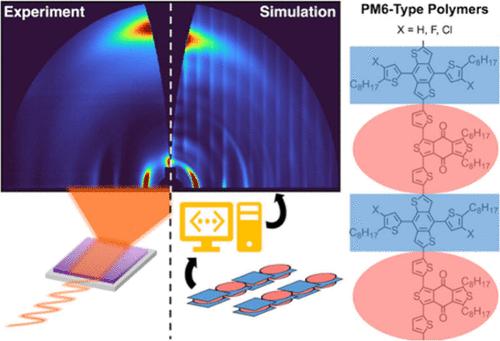溶液和膜中pm6型共轭聚合物聚集体的结构解析
IF 7
2区 材料科学
Q2 CHEMISTRY, PHYSICAL
引用次数: 0
摘要
共轭聚合物薄膜的形态是高度可调的,影响其在有机电子中的性能。具体来说,分子包装或晶体结构强烈影响电子过程,如光吸收和电荷转移。然而,高性能电子供体聚合物的单位电池仍然未知,限制了我们对加工如何影响结构和器件性能的理解。本研究通过x射线散射、低温电子显微镜和分子动力学(MD)模拟来表征pm6型推挽聚合物的聚集体结构。一种将掠入射广角x射线散射(GIWAXS)与MD相结合的正演模拟方法解决了单斜晶胞,可以准确描述薄膜和铸造溶液中的pm6型聚合物聚集体。亲密π -π堆积之间的供体和受体单位出现在这个单位细胞。使用该单元格对实验GIWAXS进行分析,量化这些聚集体中的滑动紊乱,这可能会影响设备性能。溶液聚集体的形状和内部结构也在氯苯中被识别。这些发现增强了我们对pm6型聚合物填料的理解,并概述了阐明弱有序材料晶体结构的策略。我们期望这些结果将为未来通过PM6和其他推拉共轭聚合物中的聚集体形成来控制光电性能提供机会。本文章由计算机程序翻译,如有差异,请以英文原文为准。

Deciphering the Structure of PM6-Type Conjugated Polymer Aggregates in Solution and Film
The morphology of conjugated polymer films is highly tunable, influencing their performance in organic electronics. Specifically, the molecular packing or crystal structure strongly influences electronic processes such as light absorption and charge transfer. However, the unit cells of high-performance electron donor polymers remain unknown, limiting our understanding of how processing affects structure and device performance. This study characterizes the aggregate structure of PM6-type push–pull polymers by using X-ray scattering, cryogenic electron microscopy, and molecular dynamics (MD) simulations. A forward simulation approach linking grazing-incidence wide-angle X-ray scattering (GIWAXS) with MD resolves a monoclinic unit cell that accurately describes PM6-type polymer aggregates in both thin films and casting solutions. Intimate π–π stacking between the donor and acceptor units emerges from this unit cell. Analysis of experimental GIWAXS using this unit cell quantifies sliding disorder in these aggregates, which may impact device performance. The shape and internal structure of the solution aggregates are also identified in chlorobenzene. These findings enhance our understanding of PM6-type polymer packing and outline a strategy for elucidating the crystal structures of weakly ordered materials. We expect that these results will provide future opportunities to control optoelectronic performance through aggregate formation in PM6 and other push–pull conjugated polymers.
求助全文
通过发布文献求助,成功后即可免费获取论文全文。
去求助
来源期刊

Chemistry of Materials
工程技术-材料科学:综合
CiteScore
14.10
自引率
5.80%
发文量
929
审稿时长
1.5 months
期刊介绍:
The journal Chemistry of Materials focuses on publishing original research at the intersection of materials science and chemistry. The studies published in the journal involve chemistry as a prominent component and explore topics such as the design, synthesis, characterization, processing, understanding, and application of functional or potentially functional materials. The journal covers various areas of interest, including inorganic and organic solid-state chemistry, nanomaterials, biomaterials, thin films and polymers, and composite/hybrid materials. The journal particularly seeks papers that highlight the creation or development of innovative materials with novel optical, electrical, magnetic, catalytic, or mechanical properties. It is essential that manuscripts on these topics have a primary focus on the chemistry of materials and represent a significant advancement compared to prior research. Before external reviews are sought, submitted manuscripts undergo a review process by a minimum of two editors to ensure their appropriateness for the journal and the presence of sufficient evidence of a significant advance that will be of broad interest to the materials chemistry community.
 求助内容:
求助内容: 应助结果提醒方式:
应助结果提醒方式:


